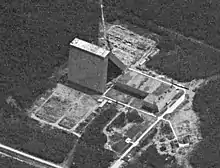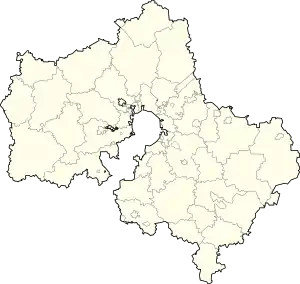A-35 anti-ballistic missile system
The A-35 anti-ballistic missile system was a Soviet military anti-ballistic missile (ABM) system deployed around Moscow to intercept enemy ballistic missiles targeting the city or its surrounding areas. The A-35 was the only Soviet ABM system allowed under the 1972 Anti-Ballistic Missile Treaty. In development since the 1960s and in operation from 1971[1] until the 1990s, it featured the nuclear-tipped A350 exoatmospheric interceptor missile. The A-35 was supported by the two Dunay radars (NATO: Cat House and Dog House) and the Soviet early warning system.[1] It was followed by the A-135 in the early 1990s.

System A
The first Soviet anti-ballistic missile system was System A which was started at Test Range A at Sary Shagan test site in July 1956.[2][3][4] The testing of System A began in 1959. System A used the V-1000 missile to intercept enemy missiles. The first launch of the V-1000 was 11 October 1957 and its first successful intercept was 4 March 1961 where it intercepted an R-12 missile launched from Kapustin Yar.[2]
System A used the Dunay-2 designed by V Sosulnikov at NII-37 (which later became NIIDAR) as well as 3 homing radars and an ABM radar.[4] The three homing radars (called RTN (NATO:Hen Egg)[5][6]) were situated in an equilateral triangle with a length of 150 kilometres (93 mi). It could track missiles from a distance of about 700 kilometres (430 mi). The V-1000 launch position and the ABM radar (called RSV-PR (NATO: Hen Nest)[5][6]) were located together. The system used an M-40 computer which could do 40,000 operations per second.[4]
A-35

The first work on A-35 started in 1959 with the test model, called Aldan. The designer of the system was Gregory Kisunko[7] of Soviet Experimental Design Bureau OKB-30. A new missile, the A-350, was to be designed by P. Grushin of OKB-2. Unlike the V-1000, the missile was to have a nuclear warhead. The design of the system called for it to be able to intercept several hostile incoming missiles simultaneously with a single warhead. It was also to intercept them outside the atmosphere.[2] A-35 was to have a main command centre, eight early warning radars with overlapping sectors, and 32 battle stations.[3]
Practical work to install the system started in 1965 but by 1967 only the test version at Sary Shagan was ready. There was an awareness that it had flaws, including an inability to handle MIRVs. In 1967 a Ministry of Defence commission decided that it should not be fully implemented.[2] The eight radars were to be reduced to the two that had been started: the Dunay-3 at Akulovo (Kubinka) (also known by the NATO codename Dog House) and the Dunay-3U at Chekhov (NATO name Cat House).[3]
In 1971 a version of A-35 was tested with the main command centre, one radar and three battle stations. The command centre was located at the same site as the Dunay-3 radar. In 1974 a version was tested with the main command with its 5E92 computer[4] and four of the eight battle stations. Each battle station had two tracking radars, two battle management radars and sixteen A-350 missiles.[3]
Only four of the eight battle stations were ever completed. Each battle station had two areas with eight missiles each. Each area had three radars, which were called TRY ADD by NATO.[5]
A-35M
The testing of A35-M began in 1977. It was a slightly modified version using A-350R rather than A-350Zh missiles.[4]
In 1971 work starting on the next generation of ABM systems - A135. Building of the Don-2N radar started in 1978 and the replacement system was placed on combat duty in 1995.[4]
A 1985 note from the archives of Vitalii Leonidovich Kataev states that the A-35M system was capable of intercepting "a single ballistic missile from some directions and up to 6 Pershing II-type missiles from the FRG".[8]
References
- "A35". Encyclopedia Astronautica. Archived from the original on 2 July 2007. Retrieved 2007-06-07.
- Gobarev, Victor (2001). "The early development of Russia's ballistic missile defense system". The Journal of Slavic Military Studies. 14 (2): 29–48. doi:10.1080/13518040108430478.
- Bukharin, Oleg; Kadyshev, Timur; Miasnikov, Eugene; Podvig, Pavel; Sutyagin, Igor; Tarashenko, Maxim; Zhelezov, Boris (2001). Podvig, Pavel (ed.). Russian Strategic Nuclear Forces. Cambridge, Massachusetts: MIT Press. ISBN 978-0-262-16202-9.
- Karpenko, A (1999). "ABM AND SPACE DEFENSE". Nevsky Bastion. 4: 2–47.
- O'Connor, Sean (2009). "Russian/Soviet Anti-Ballistic Missile Systems". Air Power Australia. Retrieved 2012-01-07.
- Holm, Michael (2011). "1st Administration". Soviet Armed Forces 1945–1991. Retrieved 2012-05-27.
- Mike Gruntman (2018). "The Man Who Shot Down a Long-Range Ballistic Missile: 100th Anniversary of the Birth of Grigorii V. Kisun'ko" (PDF). 69-th International Astronautical Congress. Bremen, Germany. IAC-18-E4-1-08.
- http://russianforces.org/blog/2012/10/very_modest_expectations_sovie.shtml
Further reading
- Mike Gruntman (2015). Intercept 1961 : The Birth of Soviet Missile Defense. Reston, VA. ISBN 1624103499.
- Mike Gruntman (2016). "Intercept 1961: From Air Defense SA-1 to Missile Defense System A". Proceedings of the IEEE. 104 (4): 883–890. doi:10.1109/JPROC.2016.2537023.